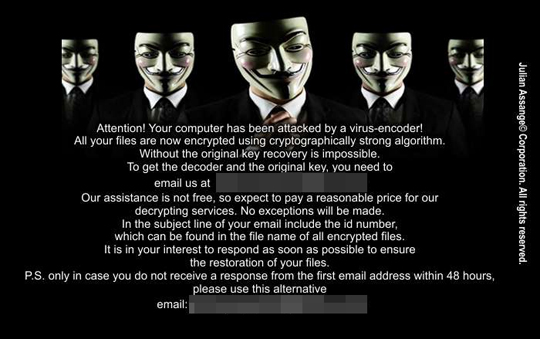Ransom.Win32.POTTIEQ.A
Trojan-Ransom.Win32.Aura.aam (KASPERSKY), Ransom:Win32/Pottieq.A (MICROSOFT)
Windows


Threat Type: Ransomware
Destructiveness: No
Encrypted: No
In the wild: Yes
OVERVIEW
Dropped by other malware, Downloaded from the Internet
This Ransomware arrives on a system as a file dropped by other malware or as a file downloaded unknowingly by users when visiting malicious sites.
It gathers information and reports it to its servers.
It encrypts files with specific file extensions. It drops files as ransom note.
TECHNICAL DETAILS
1,961,984 bytes
EXE
No
31 Aug 2018
Displays graphics/image, Connects to URLs/IPs, Steals information, Encrypts files
Arrival Details
This Ransomware arrives on a system as a file dropped by other malware or as a file downloaded unknowingly by users when visiting malicious sites.
Installation
This Ransomware drops the following files:
- %User Startup%\{GUID}.bmp
(Note: %User Startup% is the current user's Startup folder, which is usually C:\Windows\Profiles\{user name}\Start Menu\Programs\Startup on Windows 98 and ME, C:\WINNT\Profiles\{user name}\Start Menu\Programs\Startup on Windows NT, C:\Documents and Settings\{User name}\Start Menu\Programs\Startup on Windows XP, or C:\Users\{user name}\AppData\Roaming\Microsoft\Windows\Start Menu\Programs\Startup on Windows Vista, 7, and 8.)
It drops the following copies of itself into the affected system:
- %User Startup%\{GUID}.exe
(Note: %User Startup% is the current user's Startup folder, which is usually C:\Windows\Profiles\{user name}\Start Menu\Programs\Startup on Windows 98 and ME, C:\WINNT\Profiles\{user name}\Start Menu\Programs\Startup on Windows NT, C:\Documents and Settings\{User name}\Start Menu\Programs\Startup on Windows XP, or C:\Users\{user name}\AppData\Roaming\Microsoft\Windows\Start Menu\Programs\Startup on Windows Vista, 7, and 8.)
Autostart Technique
This Ransomware creates the following registry entries to enable automatic execution of dropped component at every system startup:
HKEY_CURRENT_USER\Software\Microsoft\
Windows\CurrentVersion\Run
{GUID} = "%User Startup%\{GUID}.exe"
Other System Modifications
This Ransomware adds the following registry keys:
HKEY_CURRENT_USER\Control Panel\Desktop
{Default} = "%User Startup%\{GUID}.bmp"
It changes the desktop wallpaper by modifying the following registry entries:
HKEY_CURRENT_USER\Control Panel\Desktop
WallpaperStyle = "0"
HKEY_CURRENT_USER\Control Panel\Desktop
Wallpaper = "%User Startup%\{GUID}.bmp"
It sets the system's desktop wallpaper to the following image:
Stolen Information
This Ransomware sends the gathered information via HTTP POST to the following URL:
- http://{BLOCKED}het64.ru/assets/flash/pass/
Other Details
This Ransomware gathers the following information and reports it to its servers:
- ID
- GUID
- PC NAME
Ransomware Routine
This Ransomware encrypts files with the following extensions:
- jpg
- jpeg
- doc
- rtf
- xls
- zip
- db3
- rar
- 7z3gp
- cdr
- raw
- cpt
- m2v
- gzip
- docx
- odt
- avi
- mkv
- ods
- arj
- cer
- mdb
- csv
- mpeg
- mov
- ppt
- f
- nrw
- nx1
- nbd
- old
- odb
- odc
- sldprt
- wps
- sldasm
- sbs
- p12
- rx2
- rwl
- r3d
- wps
- qic
- odp
- pz3
- ptx
- pst
- txt
- pptm
- pef
- ods
- x3f
- tbl
- tis
- srw
- srf
- sr2
- spf
- sna
- sn1
- gho
- gbk
- iv2i
- keyste
- ldf
- m3d
- max
- fbf
- fdb
- fbk
- fbw
- fbx
- bak
- bkf
- bck
- cf
- erf
- as4
- asm
- asvx
- ate
- bac
- 73b
- a3d
- abf
- abk
- accdb
- 113
- xlsm
- xlsk
- xlsb
- dwg
- tib
- pwm
- wab
- key
- dt
- ppsx
- pptx
- xlsx
- 1cd
- dbf
- mp3
- prproj
- aiiso
- ots
- emlx
- svg
- aep
- pps
- flv
- ofx
- wmv
- vob
- swf
- accdt
- xml
- qif
- mp4
- qt
- xlr
- db
- pdb
- sql
- dxf
- ost
- pab
- msg
It avoids encrypting files found in the following folders:
- windows
- program files
- program files (x86)
- programdata
- system volume information
- temp
It appends the following extension to the file name of the encrypted files:
- .id-{id}-johnycryptor@{BLOCKED}l.com
It drops the following file(s) as ransom note:
- %User Startup%\{GUID}.bmp
(Note: %User Startup% is the current user's Startup folder, which is usually C:\Windows\Profiles\{user name}\Start Menu\Programs\Startup on Windows 98 and ME, C:\WINNT\Profiles\{user name}\Start Menu\Programs\Startup on Windows NT, C:\Documents and Settings\{User name}\Start Menu\Programs\Startup on Windows XP, or C:\Users\{user name}\AppData\Roaming\Microsoft\Windows\Start Menu\Programs\Startup on Windows Vista, 7, and 8.)
SOLUTION
9.850
14.552.03
08 Oct 2018
14.553.00
09 Oct 2018
Step 1
Before doing any scans, Windows XP, Windows Vista, and Windows 7 users must disable System Restore to allow full scanning of their computers.
Step 2
Note that not all files, folders, and registry keys and entries are installed on your computer during this malware's/spyware's/grayware's execution. This may be due to incomplete installation or other operating system conditions. If you do not find the same files/folders/registry information, please proceed to the next step.
Step 3
Restart in Safe Mode
Step 4
Delete this registry value
Important: Editing the Windows Registry incorrectly can lead to irreversible system malfunction. Please do this step only if you know how or you can ask assistance from your system administrator. Else, check this Microsoft article first before modifying your computer's registry.
- In HKEY_CURRENT_USER\Software\Microsoft\Windows\CurrentVersion\Run
- {GUID} = "%User Startup%\{GUID}.exe"
- {GUID} = "%User Startup%\{GUID}.exe"
- In HKEY_CURRENT_USER\Control Panel\Desktop
- {Default} = "%User Startup%\{GUID}.bmp"
- {Default} = "%User Startup%\{GUID}.bmp"
Step 5
Search and delete this file
- %User Startup%\{GUID}.bmp
- %User Startup%\{GUID}.exe
Step 6
Reset your Desktop properties
Step 7
Restart in normal mode and scan your computer with your Trend Micro product for files detected as Ransom.Win32.POTTIEQ.A. If the detected files have already been cleaned, deleted, or quarantined by your Trend Micro product, no further step is required. You may opt to simply delete the quarantined files. Please check this Knowledge Base page for more information.
Step 8
Restore encrypted files from backup.
Did this description help? Tell us how we did.



